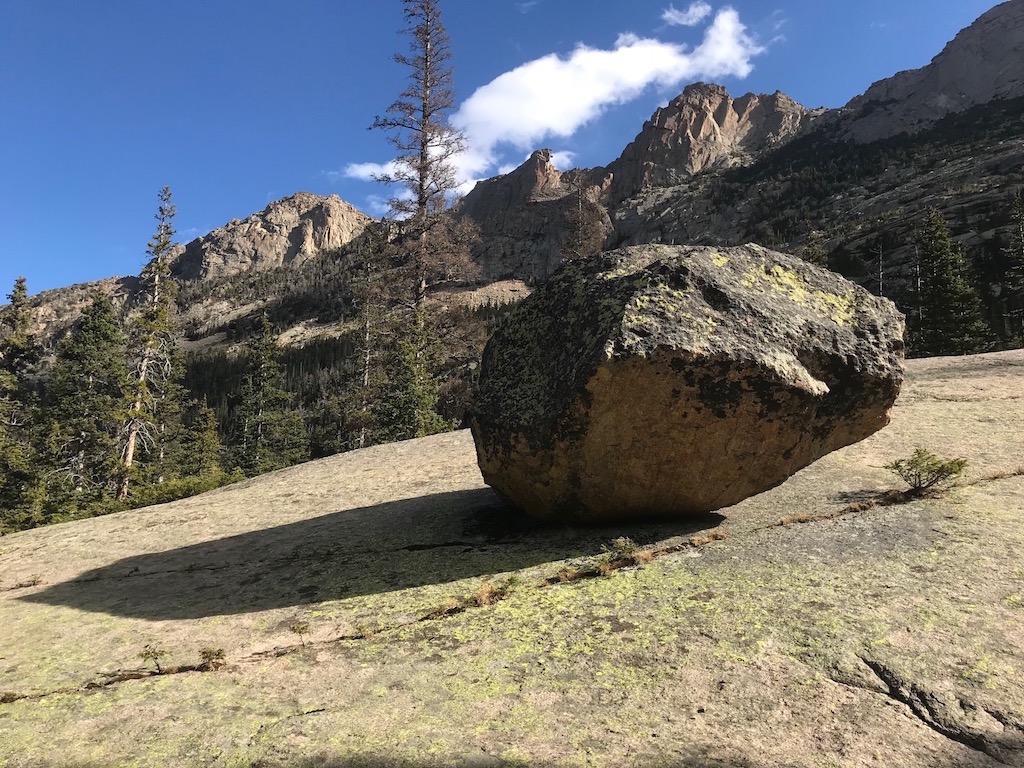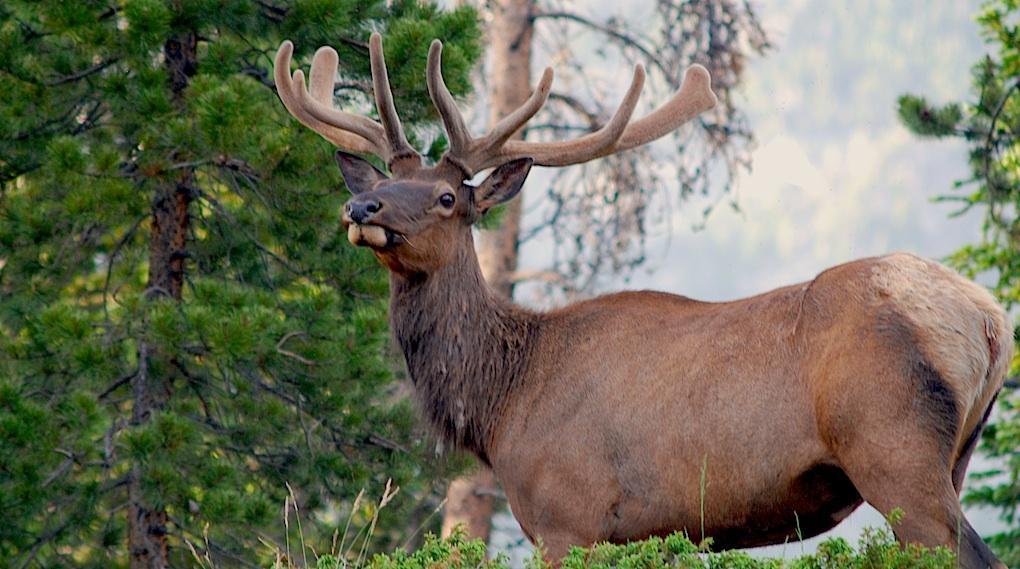
Rocky Mountain National Park is scheduled to reopen on May 27, 2020/Kurt Repanshek file
Editor's note: This updates with the park opening Wednesday, and outlines plans to move to a timed-entry system on June 4.
Rocky Mountain National Park in Colorado started to slowly reopen to the public on Wednesday, with staff monitoring visitors' behavior to determine which areas remain open and how many people will be allowed in the park.
On June 4 the monitoring will be a bit easier, as on that day the park will move temporarily to a timed-entry system that will require visitors to make reservations.
"This system will more safely manage the pace and flow of visitor use, reduce crowding, and provide an improved visitor experience in alignment with the park’s safe operational capacity," said Superintendent Darla Sidles.
Reservations to enter the park will go on sale through www.recreation.gov at 8 a.m. Mountain Time on Thursday. The first reservation window will run from June 4 through July 31. The next release will be on July 1, for the month of August and any remaining days that have not been booked for July.
On August 1, reservations will be available for the month of September and any remaining days that have not been booked for August. On September 1, reservations will be available for the month of October and any remaining days in September that have not been booked.
Permits issued using the reservation system will allow park visitors to enter the park within two-hour windows of availability between 6 a.m. through 5 p.m. This process will facilitate advance payment of entrance fees, minimize contact between park entrance station staff and visitors and limit congestion in parking lots. The permit system will apply to all areas of the park.
Fees range from $15 per day for someone entering the park on foot or bicycle, to $25 per day for private vehicles. At recreation.gov, once you set up an account you will select the day of your visit and your preferred time, add it to your cart and make the payment.
The initial opening phase allocates approximately 60 percent of the park’s maximum parking capacity which works out to 13,500 visitors per day, or 4,800 vehicles. Park staff will monitor our ability to operate with present health guidelines and adapt the system accordingly.
The booking system will be for arrivals, in blocks of two hours beginning at 6 a.m. through 5 p.m. For example, 6-8 a.m., 8-10 a.m., 10 a.m.-noon, etc. It includes advance payment of entrance fees, minimizing contact between park entrance station staff and visitors. The permit system will apply to all areas of the park (see below for more information).
There is no length-of-stay requirement, you may leave the park at any time. The only restriction is on when you can enter the park. You must enter within your reserved 2-hour window.
Visitors who have an annual park pass still need to reserve their visit, and will be charged only the $2 reservation fee.
Once you make a reservation, you'll have to print out the receipt and display it on your dashboard. The reservation only applies to access to the park, it does not guarantee access to all locations within the park. The most popular areas of the park such as Bear Lake, Alpine Visitor Center and Wild Basin could still experience vehicle restrictions due to parking limitations and congestion.
You can find an FAQ page here.
For now, the park's visitor centers will remain closed. While many outlying areas will reopen, the Wild Basin area will remain closed to all public access during this initial phase.
Trail Ridge Road will be open to Rainbow Curve on the east side and Colorado River Trailhead on the west side. Park snowplow operators continue to plow along the roadways and parking lots of Trail Ridge Road, and the full roadway will open as soon as that is completed, weather conditions permitting.
Fall River Road will be not be open to motorized vehicles, but will open to bicyclists and pedestrians. While much of the park will be accessible for visitors to enjoy, a return to full operations will continue to be phased and services will be limited. Park visitors’ actions will help determine if areas remain open.
Rocky Mountain National Park is the third-most visited national park in the country with more than 4.6 million visitors last year. Visitors experience a high level of congestion in many areas of the park from late May through early October. In 2019, visitation from June through September was over 3.2 million visitors. In July of last year alone, almost 1 million people visited the park.
Park staff will continue to monitor all park functions to ensure that visitors adhere to CDC guidance for mitigating risks associated with the transmission of COVID-19 and take any additional steps necessary to protect public health.
Winter-like conditions exist in high elevation areas of the park. Bear Lake currently has 14 inches of snow. During the ongoing health crisis, it is critical to make wise choices to keep the park rangers and first responders out of harm’s way.
Protect wildlife. Obey speed limits and be aware of wildlife. During the closure, due to lack of vehicular traffic, park rangers have observed more wildlife congregating adjacent to or on internal park roads.

Visitors are warned to watch out for wildlife, which have been more visible along roadways during the park's closure/Kurt Repanshek file
Road Construction
Road construction is ongoing on US 36 inside of Rocky Mountain National Park. The work is taking place on a 3-mile section of US 36, just west of Bear Lake Road junction to east of Deer Ridge Junction. This section of road will be closed nightly from 7 p.m. to 7 a.m., Sunday nights through Friday mornings. There will be no nightly closures on Friday and Saturday nights. When the road reopens each morning at 7 a.m. to traffic, motorists should expect delays and a rough surface.
Trail Construction:
Major trail construction continues to take place in the Alluvial Fan area after a major flood in 2013, destroyed the existing infrastructure. The park trail crew is staging a variety of material and equipment in the west Alluvial Fan parking lot and will continue construction of the accessible West Alluvial Fan Trail. Trail and boulder access to the Roaring River from the West Alluvial Fan Parking lot will be closed to park visitors from June 1 to July 31, in the Alluvial Fan area.
Campgrounds
Moraine Park and Glacier Basin Campgrounds will be partially open on June 4, with approximately half of the campsites available for reservations. Aspenglen, Timber Creek, and Longs Peak campgrounds will remain closed for the foreseeable future and may be re-evaluated for partial opening later in the summer.
Wilderness Backcountry Campsites
Wilderness camping permits will be issued beginning May 27 through the autumn.
Shuttle Bus Operations
Shuttle bus operations within the Bear Lake Road corridor will begin on May 27. In order to practice proper social distancing to minimize community spread of COVID-19, the capacity of the shuttle buses in the Bear Lake Corridor will be limited to 15 passengers per trip. Wear cloth face coverings while riding in the bus. It is unknown at this time whether the Hiker Shuttle from the Estes Park Visitor Center will be operating this summer.



Comments
Please go to the following address for information about purchasing park passes: https://www.nps.gov/planyourvisit/passes.htm. If you want an annual pass it sounds like you need to allow 4 to 5 weeks for delivery of the physical pass, or purchase at a site that sells them. I looked at the site link provided; it appears that there are mutliple sites in every state and some have many. For example, my state, which has no national parks, has 8 locations. Colorado, by my count, has 65 locations. Advance planning is going to be necessary this season.
Bevs,
I have been to Rocky many many times over the years. I hope the timed reservation system works. I hope it does spread to other parks. I hope it, or something like it, becomes a long-term practice, at least during the high season, in the busiest parks. It seems to me to be the best solution to the overcrowding the busiest parks are experiencing.
Advance planning? It's going to be necessary? You "hope the timed reservation system works" and you hope it spreads to other parks? You hope it becomes a long-term practice because it seems to me to be the best solution to overcrowding? This is my post? What are you thinking, Greg Anderson? This is America! We don't plan; we don't make no timed reservations; we don't make no reservations at all because we can't stop twitching and fidgeting long enough to think about the future, ours or anybody else's! We don't believe in reservations! They're too much like regulations and we love liberty! Nothing is ever going to be necessary for us because Jesus loves us and, if he doesn't, we can just shoplift what we need anyway. And, we don't need no stinking passes to get into national parks. We can just rev up our straight piped motorcycles and roar past the entry stations because we love freedom galldurn it! Besides, if somebody needs to pay for the park system, we can just make some other country pay for it after we invade.
Is the Grand Lake entrance open at this time?